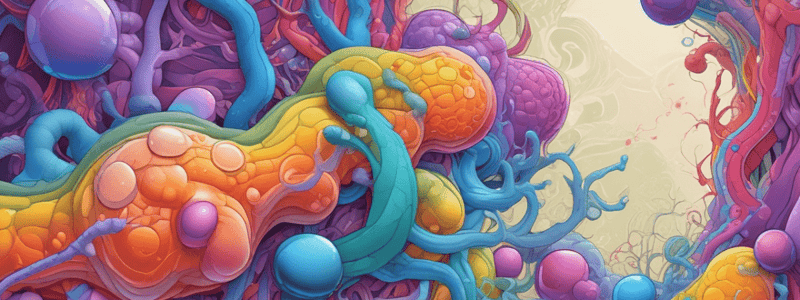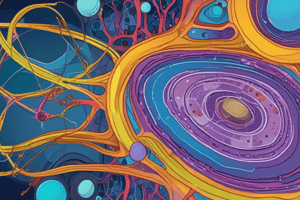Podcast
Questions and Answers
What is the primary function of primary active transport?
What is the primary function of primary active transport?
- To increase the concentration of molecules on one side of a membrane
- To utilize energy to pump molecules against their concentration gradient (correct)
- To facilitate the movement of molecules across a membrane without the use of energy
- To reduce the electrochemical gradient of one molecule to transport another molecule
Which type of transporter is responsible for the reuptake of neurotransmitters such as serotonin and noradrenaline?
Which type of transporter is responsible for the reuptake of neurotransmitters such as serotonin and noradrenaline?
- Na+/Cl- dependent transporters (SLC6) (correct)
- Vesicular transporters
- Ion transporters and pumps
- Nutrient/metabolite transporters
What is the primary function of vesicular transporters?
What is the primary function of vesicular transporters?
- To transport neurotransmitters across the plasma membrane
- To package neurotransmitters into synaptic vesicles for release (correct)
- To facilitate the movement of neurotransmitters across the synapse
- To regulate the electrochemical gradient of one molecule to transport another molecule
Which type of transporter is involved in the glutamate-glutamine shuttle?
Which type of transporter is involved in the glutamate-glutamine shuttle?
What is the primary mechanism of action of the drug Tiagabine?
What is the primary mechanism of action of the drug Tiagabine?
Which type of transporter is involved in the transport of dopamine and noradrenaline in the treatment of ADHD and depression?
Which type of transporter is involved in the transport of dopamine and noradrenaline in the treatment of ADHD and depression?
What is the primary significance of reverse transport in neurotransmitter transport?
What is the primary significance of reverse transport in neurotransmitter transport?
What is the primary function of glutamine synthase in the glutamate-glutamine shuttle?
What is the primary function of glutamine synthase in the glutamate-glutamine shuttle?
Which type of transporter is involved in the transport of excitatory amino acids (EAAs) across the postsynaptic neuron membrane?
Which type of transporter is involved in the transport of excitatory amino acids (EAAs) across the postsynaptic neuron membrane?
What is the primary mechanism of action of VMAT2 inhibitors?
What is the primary mechanism of action of VMAT2 inhibitors?
What is the primary function of facilitated diffusion in the context of neurotransmitter transport?
What is the primary function of facilitated diffusion in the context of neurotransmitter transport?
Which type of transporter is responsible for the uptake of glutamate by astrocytes in the glutamate-glutamine shuttle?
Which type of transporter is responsible for the uptake of glutamate by astrocytes in the glutamate-glutamine shuttle?
What is the primary function of the vesicular acetylcholine transporter (VAChT)?
What is the primary function of the vesicular acetylcholine transporter (VAChT)?
Which type of transporter is involved in the transport of inhibitory amino acids (IAAs) such as GABA and glycine?
Which type of transporter is involved in the transport of inhibitory amino acids (IAAs) such as GABA and glycine?
What is the primary mechanism of action of the drug fenfluramine?
What is the primary mechanism of action of the drug fenfluramine?
Which type of transporter is involved in the transport of excitatory amino acids (EAAs) such as glutamate and aspartate?
Which type of transporter is involved in the transport of excitatory amino acids (EAAs) such as glutamate and aspartate?
What is the primary function of the glutamine synthase enzyme in the glutamate-glutamine shuttle?
What is the primary function of the glutamine synthase enzyme in the glutamate-glutamine shuttle?
Which type of transporter is responsible for the reuptake of dopamine and noradrenaline in the treatment of ADHD and depression?
Which type of transporter is responsible for the reuptake of dopamine and noradrenaline in the treatment of ADHD and depression?
What is the primary significance of reverse transport in neurotransmitter transport?
What is the primary significance of reverse transport in neurotransmitter transport?
Which type of transporter is involved in the transport of monoamines such as serotonin and noradrenaline?
Which type of transporter is involved in the transport of monoamines such as serotonin and noradrenaline?
What is the purpose of the electrochemical gradient in secondary active transport?
What is the purpose of the electrochemical gradient in secondary active transport?
What is the primary function of Na+/K+ - dependent transporters?
What is the primary function of Na+/K+ - dependent transporters?
What is the effect of dysfunction or dysregulation of glutamate transporters on the synaptic cleft?
What is the effect of dysfunction or dysregulation of glutamate transporters on the synaptic cleft?
What is the primary mechanism by which fenfluramine increases serotonin levels?
What is the primary mechanism by which fenfluramine increases serotonin levels?
What is the primary function of EAAT-1 in the glutamate-glutamine shuttle?
What is the primary function of EAAT-1 in the glutamate-glutamine shuttle?
What is the effect of Tiagabine on the synaptic cleft?
What is the effect of Tiagabine on the synaptic cleft?
What is the primary function of VMAT-1 and VMAT-2?
What is the primary function of VMAT-1 and VMAT-2?
What is the primary mechanism by which dopamine reuptake transporter is involved in the treatment of ADHD?
What is the primary mechanism by which dopamine reuptake transporter is involved in the treatment of ADHD?
What is the primary function of GAT-2 and GAT-3?
What is the primary function of GAT-2 and GAT-3?
What is the primary mechanism by which VMAT2 inhibitors are involved in addiction and drug dependence?
What is the primary mechanism by which VMAT2 inhibitors are involved in addiction and drug dependence?
Study Notes
Mechanisms of Movement Through Membranes
- Facilitated diffusion: passive movement of molecules across a membrane facilitated by specific carrier proteins
- Primary active transport: utilizes energy (often from ATP hydrolysis) to pump molecules against their concentration gradient
- Secondary active transport: uses the energy stored in the electrochemical gradient of one molecule to transport another molecule against its gradient
Transporter Types
- Ion transporters and pumps: Na-K ATPase, Na/Ca exchangers
- Nutrient/metabolite transporters: nucleosides, glucose
- Neurotransmitter transporters: monoamines (serotonin, noradrenaline, dopamine), inhibitory amino acids (GABA, glycine), excitatory amino acids (glutamate, aspartate), acetylcholine, neuroactive peptides (substance P)
Neurotransmitter Removal Methods
- Passive diffusion: applicable to all neurotransmitters
- Enzymatic degradation: important for peptides and acetylcholine (broken down by acetylcholinesterase to acetate and choline, then taken up by choline transporter)
- Re-uptake by transporters: important for monoamine and amino acid neurotransmitters
Neurotransmitter Transporter Types
- Plasma membrane transporters: Na+/Cl- dependent transporters (SLC6), Na+/K+ dependent transporters (SLC1a)
- Vesicular transporters: packages transmitters into synaptic vesicles for release, types include VMAT-1, VMAT-2, VAchT, VIAAT, Vglut-1, Vglut-2, Vglut-3
Glutamate Transporters
- 5 isoforms: EAAT-1 (primarily glial), EAAT-2 (glial and some neuronal), EAAT-3 (primarily neuronal), EAAT-4 (primarily neuronal), EAAT-5 (retinal)
- Glutamate-glutamine shuttle: astrocytes convert glutamate into glutamine, which is then transported back to neurons to be converted back into glutamate
Astrocyte Transporters
- Glutamate: EAAT1, EAAT2
- GABA: GAT-2, GAT-3
Epilepsy and Neurotransmitter Transporters
- Dysfunction or dysregulation of glutamate transporters can lead to excessive glutamate accumulation in the synaptic cleft, causing excitotoxicity and neuronal damage
- Dysfunction of GABA transporters can disrupt the balance between excitation and inhibition, leading to hyperexcitability and seizure generation
Mechanisms of Movement Through Membranes
- Facilitated diffusion: passive movement of molecules across a membrane facilitated by specific carrier proteins
- Primary active transport: utilizes energy (often from ATP hydrolysis) to pump molecules against their concentration gradient
- Secondary active transport: uses the energy stored in the electrochemical gradient of one molecule to transport another molecule against its gradient
Transporter Types
- Ion transporters and pumps: Na-K ATPase, Na/Ca exchangers
- Nutrient/metabolite transporters: nucleosides, glucose
- Neurotransmitter transporters: monoamines (serotonin, noradrenaline, dopamine), inhibitory amino acids (GABA, glycine), excitatory amino acids (glutamate, aspartate), acetylcholine, neuroactive peptides (substance P)
Neurotransmitter Removal Methods
- Passive diffusion: applicable to all neurotransmitters
- Enzymatic degradation: important for peptides and acetylcholine (broken down by acetylcholinesterase to acetate and choline, then taken up by choline transporter)
- Re-uptake by transporters: important for monoamine and amino acid neurotransmitters
Neurotransmitter Transporter Types
- Plasma membrane transporters: Na+/Cl- dependent transporters (SLC6), Na+/K+ dependent transporters (SLC1a)
- Vesicular transporters: packages transmitters into synaptic vesicles for release, types include VMAT-1, VMAT-2, VAchT, VIAAT, Vglut-1, Vglut-2, Vglut-3
Glutamate Transporters
- 5 isoforms: EAAT-1 (primarily glial), EAAT-2 (glial and some neuronal), EAAT-3 (primarily neuronal), EAAT-4 (primarily neuronal), EAAT-5 (retinal)
- Glutamate-glutamine shuttle: astrocytes convert glutamate into glutamine, which is then transported back to neurons to be converted back into glutamate
Astrocyte Transporters
- Glutamate: EAAT1, EAAT2
- GABA: GAT-2, GAT-3
Epilepsy and Neurotransmitter Transporters
- Dysfunction or dysregulation of glutamate transporters can lead to excessive glutamate accumulation in the synaptic cleft, causing excitotoxicity and neuronal damage
- Dysfunction of GABA transporters can disrupt the balance between excitation and inhibition, leading to hyperexcitability and seizure generation
Mechanisms of Movement Through Membranes
- Facilitated diffusion: passive movement of molecules across a membrane facilitated by specific carrier proteins
- Primary active transport: utilizes energy (often from ATP hydrolysis) to pump molecules against their concentration gradient
- Secondary active transport: uses the energy stored in the electrochemical gradient of one molecule to transport another molecule against its gradient
Transporter Types
- Ion transporters and pumps: Na-K ATPase, Na/Ca exchangers
- Nutrient/metabolite transporters: nucleosides, glucose
- Neurotransmitter transporters: monoamines (serotonin, noradrenaline, dopamine), inhibitory amino acids (GABA, glycine), excitatory amino acids (glutamate, aspartate), acetylcholine, neuroactive peptides (substance P)
Neurotransmitter Removal Methods
- Passive diffusion: applicable to all neurotransmitters
- Enzymatic degradation: important for peptides and acetylcholine (broken down by acetylcholinesterase to acetate and choline, then taken up by choline transporter)
- Re-uptake by transporters: important for monoamine and amino acid neurotransmitters
Neurotransmitter Transporter Types
- Plasma membrane transporters: Na+/Cl- dependent transporters (SLC6), Na+/K+ dependent transporters (SLC1a)
- Vesicular transporters: packages transmitters into synaptic vesicles for release, types include VMAT-1, VMAT-2, VAchT, VIAAT, Vglut-1, Vglut-2, Vglut-3
Glutamate Transporters
- 5 isoforms: EAAT-1 (primarily glial), EAAT-2 (glial and some neuronal), EAAT-3 (primarily neuronal), EAAT-4 (primarily neuronal), EAAT-5 (retinal)
- Glutamate-glutamine shuttle: astrocytes convert glutamate into glutamine, which is then transported back to neurons to be converted back into glutamate
Astrocyte Transporters
- Glutamate: EAAT1, EAAT2
- GABA: GAT-2, GAT-3
Epilepsy and Neurotransmitter Transporters
- Dysfunction or dysregulation of glutamate transporters can lead to excessive glutamate accumulation in the synaptic cleft, causing excitotoxicity and neuronal damage
- Dysfunction of GABA transporters can disrupt the balance between excitation and inhibition, leading to hyperexcitability and seizure generation
Studying That Suits You
Use AI to generate personalized quizzes and flashcards to suit your learning preferences.
Description
This quiz covers the different mechanisms of movement through cell membranes, including facilitated diffusion, primary and secondary active transport, and the roles of carrier proteins and ion transporters. Test your knowledge of these crucial biological processes.



